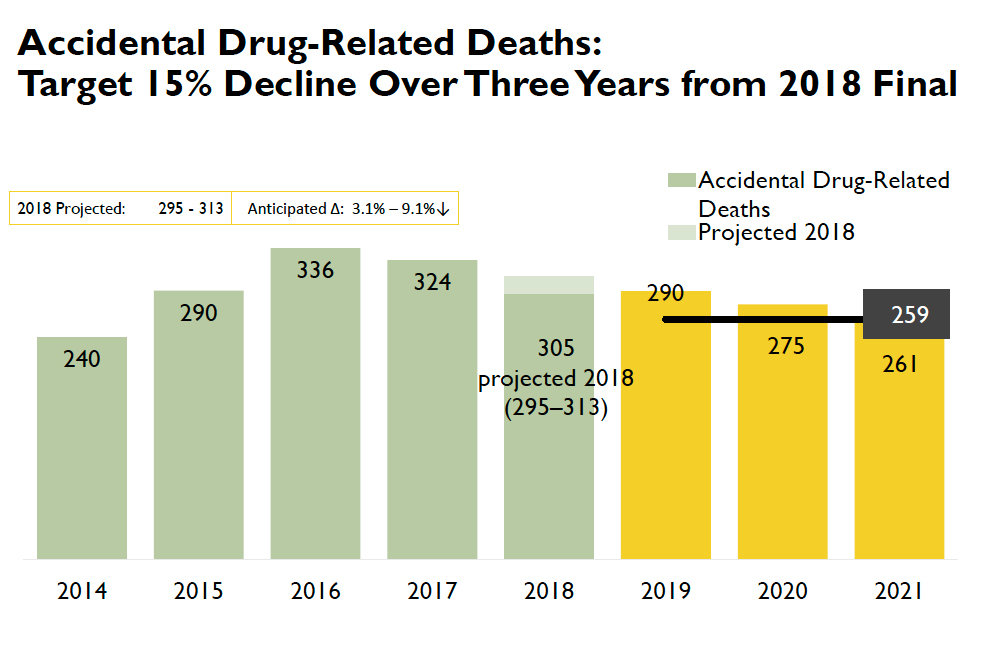Data that makes a difference
There are still omissions in the efforts by the Governor’s Task Force on OD Prevention and Intervention in reshaping the metrics it is tracking
Without that positive vision of a life worth living, it is easy to succumb to the pain of loneliness and social isolation.
PROVIDENCE – At the monthly meeting of the Task Force on Overdose Prevention and Intervention held on Wednesday, March 13, with an overflow crowd approaching 160 people, Kimberly Paull, the director of Data and Analytics at the R.I. Executive Office of Health and Human Services, presented an overview of the draft metrics to be included in the 2019-2021 strategic plan.
It included 16 measures where data exist and are already being reported, 7 measures where data may need to be linked or processed, and 2 measures where the data source or metric does not yet exist.
The effort, in large part, seeks to move beyond the perverse metric of counting the number of deaths as a result of overdoses as measure of success, such as: tracking new monthly enrollments in recovery support services; tracking the percent of overdoses reported to have received naloxone before arriving at the emergency room; and tracking primary prevention programs in schools and communities, including the work being done by health equity zones.
The metrics conform to the four pillars of the strategic approach of the task force: prevention, rescue, treatment and recovery, drilling down to granular detail, such as: tracking the number of people with a new opioid use disorder connected to treatment or recovery services within six months, with a 12-month look back.
Glaring omission?
One glaring omission in the metrics was the lack of any tracking in the distribution of fentanyl test strips in Rhode Island, as a harm reduction tool, often included as part of a naloxone kit by community recovery advocacy groups.
Since August of 2018, there have been some 8,000 fentanyl testing strips purchased and distributed in Rhode Island, under the protection of the Good Samaritan Act. The fentanyl test strips cost about $1 each; they are accurate about 98 percent of the time in detecting the presence of fentanyl in illicit drugs, including heroin and cocaine. Fentanyl has been linked more than 60 percent of the deaths in overdoses occurring in Rhode Island in 2017.
The first 1,000 were purchased by state agencies to be distributed as part of Overdose Awareness on Aug. 31, 2018. A second batch of 3,000 fentanyl test strips were purchased in January of 2019 by state agencies for distribution by community groups. A third batch of 4,000 fentanyl test strips was purchased by RICARES, through a private donation, for distribution to community groups.
It would seem to make sense as a metric moving forward to track the distribution of fentanyl test strips and see if their use in communities can be correlated with any potential reductions in overdose deaths.
However, when ConvergenceRI asked Paull whether any data was being compiled regarding the metrics of fentanyl test strip use, she punted the question to Max Krieger, a researcher at the Brown University School of Public Health, who indicated that there had been some positive data in response to the distribution of fentanyl test strips.
The answer surprised Dr. James McDonald, medical director at the R.I. Department of Health, who asked Krieger after the meeting about his statement and the source of his data. It turned out that Krieger did not have any data about the current distribution of fentanyl test strips in Rhode Island; in other words, he prevaricated.
Such false statements by researchers at a Task Force meeting undercut the credibility and diminish the accountability of the work being done, in ConvergenceRI’s opinion.
Expanding the universe of metrics
The lack of inclusion of data about the distribution and use of fentanyl test strips as a harm reduction tool in saving lives, and in preventing and intervening around drug overdoses in Rhode Island, could be easily remedied.
It would seem to be an important metric to capture as a data point – as a measure of saving lives.
The problem, it appears, according to sources, is not with the capability to do so but with the resistance to include harm reduction as a component within the 2019-2021 Task Force Strategic Plan.
For that matter, there is still no comprehensive data set included in the Task Force metrics that looks at the diseases of despair, the number of deaths from alcohol, suicide in Rhode Island, which are ravaging the 25-34 age group demographic.
The purpose of public forums
One of the popular ongoing tactics in the efforts to address the opioid epidemic is to hold public forums, featuring expert panelists to discuss what is being done.
On Saturday, March 9, ConvergenceRI went to a sparsely attended forum sponsored by BrainWeek RI. As much as the panelists brought a wealth of knowledge to the conversation, it seemed, from the audience perspective, it was a discussion in search of a target audience. Who were they supposed to be talking to?
Later that afternoon, ConvergenceRI had the opportunity to view a rebroadcast of a recent ABC6 production about the opioid epidemic in Rhode Island. Here, the problem was the focus of the questions asked by the moderator of the panel, which the panelists had no input into helping to develop.
If the BrainWeek RI session seemed confused about whom it was talking to as an audience, the ABC6 production kept veering off on bizarre tangents that seemed to distort the conversation.
The takeaway from both events reflects what seems to be a growing disconnect between the audience for such discussions and the woeful lack of knowledge by TV producers about the actual conversations that are occurring in the community, on the street, and in recovery centers.






